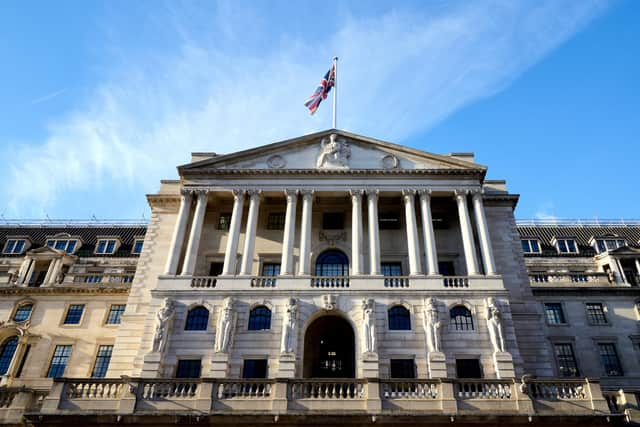Interest rates analysis: Bank of England getting it right and wrong with latest move
As widely anticipated, the central bank lifted the base rate by a further quarter point to 4.5 per cent as it attempts to put a lid on soaring inflation - much of it fuelled by global energy costs that are beyond its control. It marks the 12th increase since December 2021 and takes borrowing costs to the highest level since the 2008 financial crisis. Of course, most personal and business borrowers will be facing percentage rates several points above that 4.5 per cent base rate. Those with savings will be hoping for an interest rate boost, though many institutions have been painfully slow to pass on the advantages of fiscal tightening.
Seven members of the Bank of England’s monetary policy committee (MPC) voted to increase the base interest rate to 4.5 per cent from 4.25 per cent. Food prices have stayed higher for longer than expected, the Bank noted, partly due to the conflict in Ukraine and poor harvests in some European countries, ramping up the cost of living for households across the UK. Inflation is still expected to drop sharply from April this year, as energy prices decline and household bills are subsidised, the MPC said, though several commentators are now questioning whether Prime Minister Rishi Sunak can meet his pledge of halving double-digit inflation by the end of the year. The Bank had previously thought consumer price inflation could fall as low as 1 per cent by the middle of 2024 but it is now predicted to reach around 3.4 per cent.
Advertisement
Hide AdAdvertisement
Hide AdThe TUC said the latest interest rate rise would “make a bad situation worse”, arguing that working people needed “decent pay rises” to keep up with the cost of living. TUC general secretary Paul Nowak said: “With the UK economy flatlining, and the value of everyone’s pay plummeting, another rate rise will make a bad situation worse. The priority should be protecting living standards and boosting the economy to safeguard people’s jobs.”
Susannah Streeter, head of money and markets at investment platform Hargreaves Lansdown, said the battle to tame inflation looked far from over, with the road “wide open for another hike”. Noting that the pound had risen against the dollar, as the US Federal Reserve and Bank of England look set to diverge on policy, she said: “The rate raising marathon has passed yet another milestone as policymakers try and pull back runaway inflation. The hike of 0.25 per cent pushing the base rate to 4.5 per cent was widely forecast, given that super-hot consumer prices are failing to cool off quickly despite rapid tightening. With wages staying elevated and consumer resilience strong, the finishing line of rate hikes may still be way off.
“Although the Bank expects inflation to drop to 5.1 per cent by the end of this year from 10.1 per cent in March, it’s in contrast to the fall to the 3.9 per cent level it predicted in February, with food prices expected to stay stubbornly high. But the Bank is also admitting that the price spiral may prove harder to come down than it previously expected, citing upward risks to forecasts, and that’s why the road still seems wide open for another hike.”
Trevor Williams, chair of the think-tank Institute of Economic Affairs’ shadow monetary policy committee and former chief economist at Lloyds Bank, said the Bank of England was at significant risk of overcorrecting. He warned: “Just as the Bank of England failed to identify inflationary pressures at the tail end of the Covid-19 pandemic, they may be once again focusing too much on present inflation rather than long run trends. The sharp reduction in the money supply points towards inflation coming down quickly over the coming two years. The UK’s sluggish economic growth, easing supply chain pressures and a series of recent bank failures also point against the need for further rate rises.”
Meanwhile, economists at the central bank released a marked upgrade to their economic growth expectations. They now expect that gross domestic product (GDP) will not fall during a single quarter this year, meaning the economy is not set to decline and the UK could avoid a recession. In February, the committee believed the economy could fall into a shallow recession starting from the first three months of the year.


Now it expects GDP to rise by 0.25 per cent this year before a 0.75 per cent increase next year and the year after. It had previously forecast a 0.5 per cent fall this year, followed by a drop of 0.25 per cent next year and a 0.25 per cent rise in 2025. The increase of 2.25 percentage points over the three-year forecast period marked the biggest upgrade since the MPC was formed in 1997.
Mairi Spowage, director of the Fraser of Allander Institute at the University of Strathclyde, said: “The Bank’s outlook for the UK economy has improved considerably since their last set of forecasts were published in February. Broadly in line with the Office for Budget Responsibility, they now think that the UK economy will overall be flat in the first half of 2023 before returning to growth in the second half of the year. The Bank’s expectations are still for inflation to fall sharply from April, in part as the high price levels from a year ago come into the comparison.”
Comments
Want to join the conversation? Please or to comment on this article.